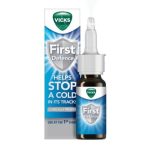Can I Put Vicks VapoRub in My Nose?

When it comes to alleviating cold symptoms and nasal congestion, Vicks VapoRub has been a long-standing favorite in households around the world. Its unique blend of menthol, camphor, and eucalyptus oil has earned it a reputation for providing soothing relief. However, as popular as this topical ointment is, there remains an ongoing debate concerning its safety and effectiveness when used inside the nose.
In this article, we delve into the advantages, potential risks, and best practices associated with using Vicks VapoRub in the nasal passages, aiming to offer you a comprehensive understanding of this widely used home remedy.
What is Vicks VapoRub?
Vicks VapoRub, a time-tested product that has withstood the test of generations, has long been trusted as a go-to remedy for easing respiratory discomfort.
Vicks VapoRub contains a blend of active and inactive ingredients carefully chosen to provide soothing relief from common cold symptoms and nasal congestion. The active ingredients in Vicks VapoRub include:
1. Camphor (4.8%): Camphor is a natural compound derived from the wood of the camphor tree. It has a cooling effect on the skin and mucous membranes, which helps alleviate congestion and ease respiratory discomfort.
2. Menthol (2.6%): Menthol is an organic compound derived from mint plants, such as peppermint and eucalyptus. It produces a cooling sensation and can help open up the airways, providing relief from nasal congestion and improving breathing.
3. Eucalyptus Oil (1.2%): Eucalyptus oil is obtained from the leaves of eucalyptus trees. It has a pleasant aroma and is known for its potential benefits in easing respiratory symptoms, such as cough and congestion.
The inactive ingredients in Vicks VapoRub include:
1. Cedarleaf Oil
2. Nutmeg Oil
3. Special Petrolatum
4. Thymol
5. Turpentine Oil
These inactive ingredients serve as carriers for the active compounds and contribute to the ointment’s texture and overall effectiveness.
It’s important to note that the percentages of active ingredients can vary slightly between different formulations and products. Always read the product label to ensure you are using the correct Vicks VapoRub product and follow the recommended usage guidelines provided by the manufacturer. Additionally, individuals with allergies or sensitivities to any of the ingredients should exercise caution and consult a healthcare professional before using Vicks VapoRub.
This topical ointment is designed to provide a cooling sensation that aids in opening up airways and providing relief from congestion. However, while Vicks VapoRub is generally considered safe for external application, concerns arise when considering its use inside the nose.
Examining the Pros of Using Vicks VapoRub on the Nose
Some individuals have explored the idea of applying Vicks VapoRub inside their nostrils to achieve added relief from nasal congestion or sinus issues. While the manufacturer’s guidelines do not recommend this usage, proponents of nasal application cite potential benefits that are worth considering:
1. Nasal Congestion Relief: The aromatic properties of Vicks VapoRub, when inhaled through the nose, may provide a mild sensation of relief, temporarily easing nasal congestion.
2. Soothing Effects: The cooling menthol and camphor in Vicks VapoRub can offer a comforting sensation when applied to the nasal passages.
Assessing Potential Risks and Side Effects
Despite its potential benefits, using Vicks VapoRub in the nose comes with several noteworthy risks and side effects:
1. Irritation and Sensitization: The delicate tissues inside the nose may react to the strong menthol and camphor, leading to irritation or allergic reactions.
2. Inhalation Concerns: Applying Vicks VapoRub directly inside the nose can result in inadvertent inhalation of its active ingredients, possibly causing respiratory discomfort or issues.
3. Damage to Mucous Membranes: Vicks VapoRub may dry out the nasal passages, leading to further irritation and discomfort.
Exploring Safety Considerations
Considering the potential risks involved, certain groups of individuals should exercise particular caution or avoid using Vicks VapoRub in the nose altogether:
1. Children and Infants: Using Vicks VapoRub in the nose is not recommended for children under the age of two due to the risk of respiratory distress.
2. Pregnant and Nursing Women: Pregnant and nursing women should seek medical advice before using Vicks VapoRub in any form.
3. People with Respiratory Conditions: Individuals with asthma or other respiratory conditions should avoid using Vicks VapoRub in the nose, as it may exacerbate their symptoms.
Promoting Best Practices for Safe Usage
To ensure safety and effective symptom relief, consider these alternative methods of utilizing Vicks VapoRub:
1. External Application: Stick to the traditional method of applying Vicks VapoRub on the chest or throat for congestion relief.
2. Aromatherapy Diffusers: Consider using a humidifier or aromatherapy diffuser to disperse the vapors in the air for inhalation without direct nasal application.
3. Nasal Saline Solutions: Opt for medically approved saline solutions to moisturize and relieve nasal congestion without potential risks.
4. Consult a Healthcare Professional: Seek advice from a qualified healthcare provider if you have any concerns or pre-existing medical conditions before using Vicks VapoRub.
Conclusion
While Vicks VapoRub has garnered a loyal following for its effectiveness in relieving common cold symptoms, applying it inside the nose comes with potential risks that should not be overlooked. The decision to use Vicks VapoRub in this manner should be made with careful consideration of the potential benefits and risks, and always in adherence to safety guidelines. Ultimately, the priority should be to ensure the health and well-being of individuals seeking relief from nasal congestion and respiratory discomfort.





